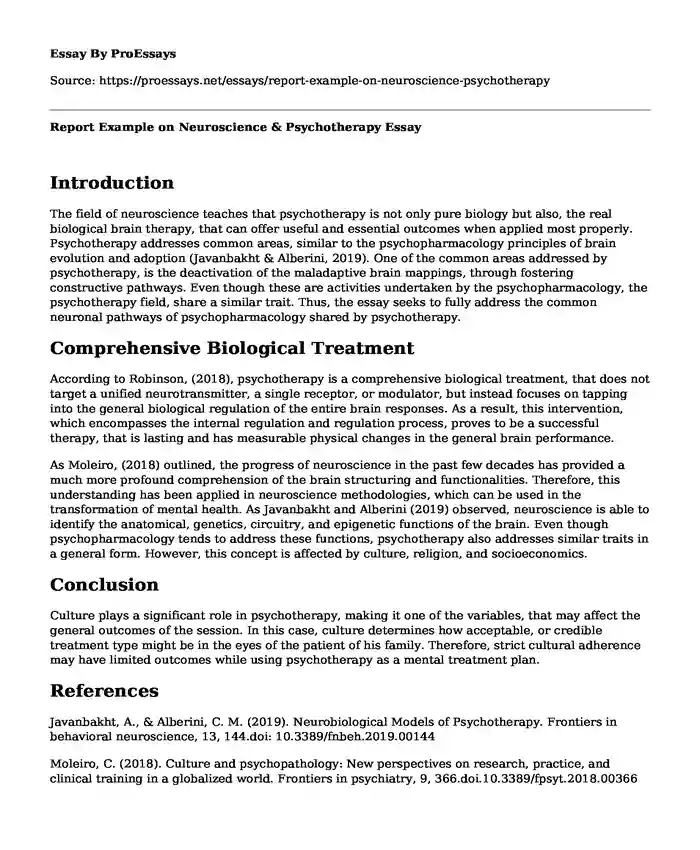Introduction
The field of neuroscience teaches that psychotherapy is not only pure biology but also, the real biological brain therapy, that can offer useful and essential outcomes when applied most properly. Psychotherapy addresses common areas, similar to the psychopharmacology principles of brain evolution and adoption (Javanbakht & Alberini, 2019). One of the common areas addressed by psychotherapy, is the deactivation of the maladaptive brain mappings, through fostering constructive pathways. Even though these are activities undertaken by the psychopharmacology, the psychotherapy field, share a similar trait. Thus, the essay seeks to fully address the common neuronal pathways of psychopharmacology shared by psychotherapy.
Comprehensive Biological Treatment
According to Robinson, (2018), psychotherapy is a comprehensive biological treatment, that does not target a unified neurotransmitter, a single receptor, or modulator, but instead focuses on tapping into the general biological regulation of the entire brain responses. As a result, this intervention, which encompasses the internal regulation and regulation process, proves to be a successful therapy, that is lasting and has measurable physical changes in the general brain performance.
As Moleiro, (2018) outlined, the progress of neuroscience in the past few decades has provided a much more profound comprehension of the brain structuring and functionalities. Therefore, this understanding has been applied in neuroscience methodologies, which can be used in the transformation of mental health. As Javanbakht and Alberini (2019) observed, neuroscience is able to identify the anatomical, genetics, circuitry, and epigenetic functions of the brain. Even though psychopharmacology tends to address these functions, psychotherapy also addresses similar traits in a general form. However, this concept is affected by culture, religion, and socioeconomics.
Conclusion
Culture plays a significant role in psychotherapy, making it one of the variables, that may affect the general outcomes of the session. In this case, culture determines how acceptable, or credible treatment type might be in the eyes of the patient of his family. Therefore, strict cultural adherence may have limited outcomes while using psychotherapy as a mental treatment plan.
References
Javanbakht, A., & Alberini, C. M. (2019). Neurobiological Models of Psychotherapy. Frontiers in behavioral neuroscience, 13, 144.doi: 10.3389/fnbeh.2019.00144
Moleiro, C. (2018). Culture and psychopathology: New perspectives on research, practice, and clinical training in a globalized world. Frontiers in psychiatry, 9, 366.doi.10.3389/fpsyt.2018.00366
Robinson, E. (2018). Psychopharmacology: From serendipitous discoveries to rationale design, but what next? Brain and Neuroscience Advances, 2, 2398212818812629.doi.org/10.1177/2398212818812629.
Cite this page
Report Example on Neuroscience & Psychotherapy. (2023, Nov 16). Retrieved from https://proessays.net/essays/report-example-on-neuroscience-psychotherapy
If you are the original author of this essay and no longer wish to have it published on the ProEssays website, please click below to request its removal:
- Research Paper on Behavioural and Communicative Functioning of Children With Autism Spectrum Disorder
- Essay Example on Public Policy: Loan Forgiveness to Ease Student Financial Stress
- Essay Sample on Personality: Nature vs Nurture
- Paper Example on Case Manager & Client: Achieving Mental Health Goals Together
- Self-Concept: A Social Construct - Essay Sample
- Essay Example on Preparing Glassware for Synthesis: Cleaning, Washing & Drying
- Essay Example on College Students and Alcohol Use Disorder: Examining DSM-5 Criteria







